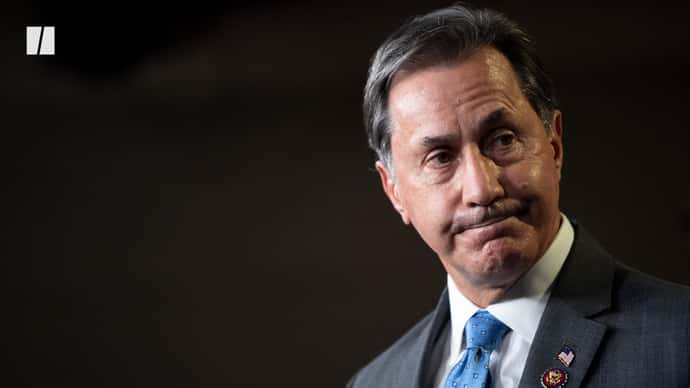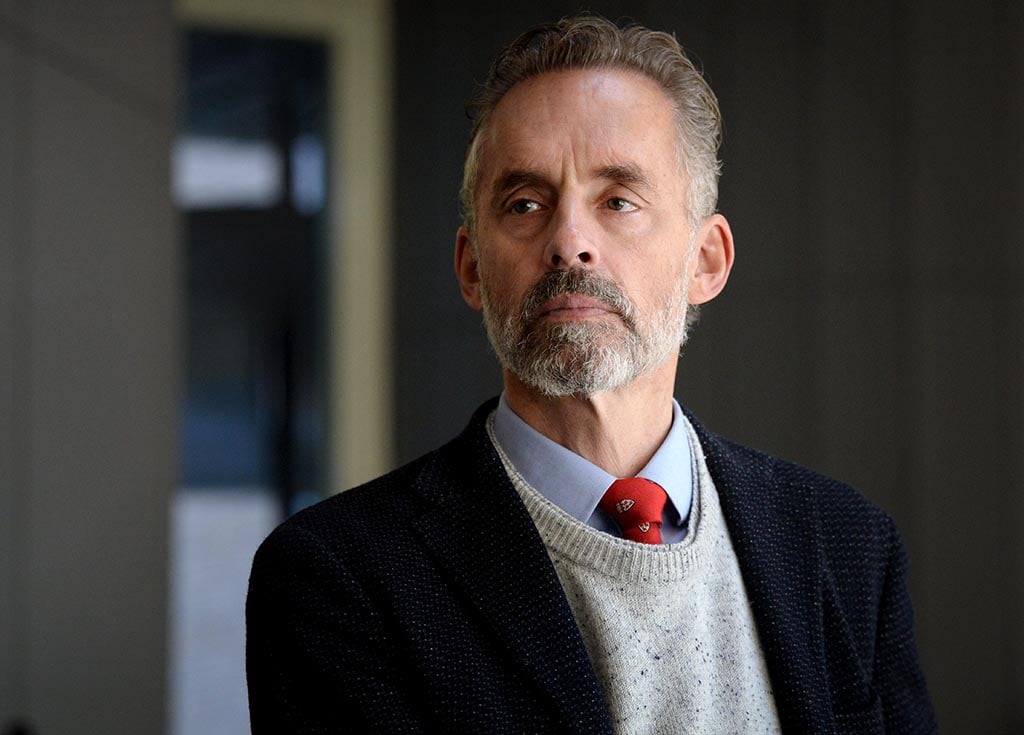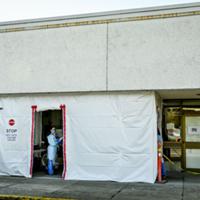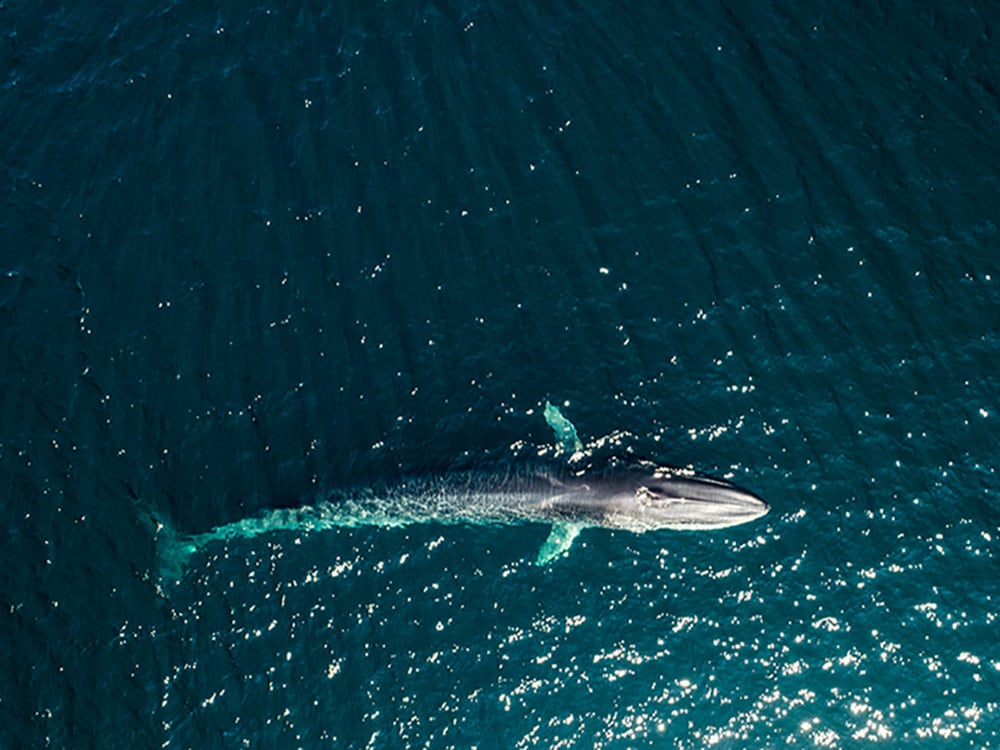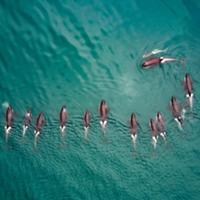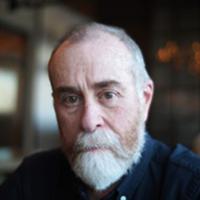This Is ‘Kenneyism’
How the unpopular premier’s recipe of intimidation, disinformation and sweeping new laws is transforming Alberta’s culture.
Taylor Lambert 17 Jan 2022 | TheTyee.ca
Taylor Lambert has written three non-fiction books about Alberta. He lives in Calgary. Find him on Twitter @ts_lambert.
LONG READ
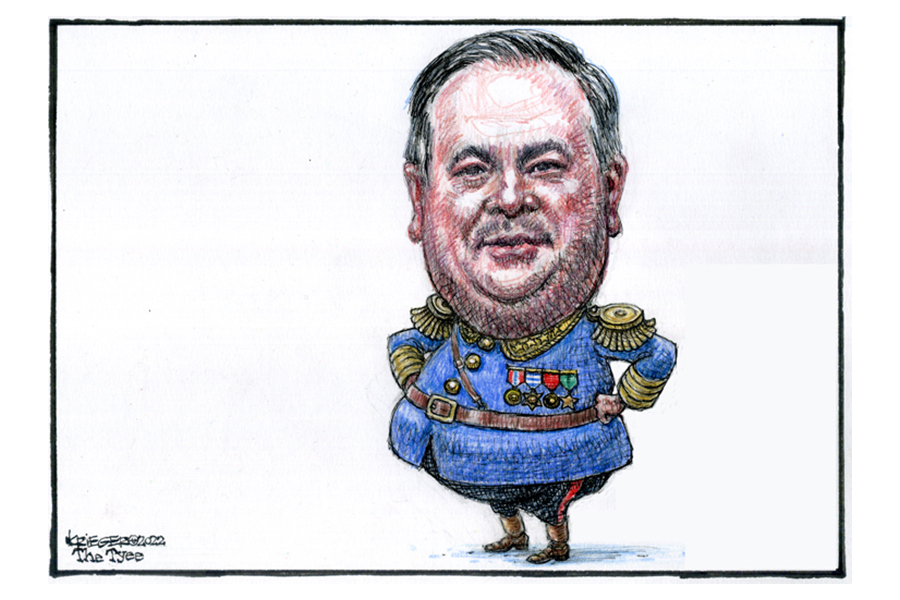
Kenney’s authoritarian tactics aim to quash dissent and have targeted not just academia and unions but even art students. Illustration for The Tyee by Bob Krieger.
When Jesse Drwiega won the Queen’s Golden Jubilee Award for Performing and Visual Arts in 2020, he was thrilled. The prestigious honour provided the 25-year-old actor, singer and dancer from Red Deer a $5,000 scholarship as he prepared to pursue his master’s in theatre studies.
In a year with plenty of gripping issues to choose from, these were the big draws in our pages.
As requested, Drwiega wrote and recorded an acceptance speech and, on the night of the online event, tuned in to watch. But when his name was announced the ceremony moved on without playing his video statement.
Drwiega quickly realized what was going on.
A few days before, he’d received a call from an Alberta government official who’d asked him to re-record his video. Specifically, would Drwiega drop his brief mention of being disappointed with recent cuts to arts funding? The lieutenant-governor was going to be in attendance, and the government would prefer such views be deleted.
Drwiega had said no. He believed he had a right to respectfully express an opinion — especially given the ceremony was dedicated to students in the arts.
The Tyee is supported by readers like you Join us and grow independent media in Canada
It had made him mad to have to stand his ground. And now, upon seeing himself all but erased from the event, anger gave way to shock.
So he posted the missing 85-second video to Facebook, including the part where he said he was “saddened” by the government’s cuts to arts and education, and also the part where he cheerfully thanked the 25th legislature, under Ralph Klein, for establishing the award in the first place. Noting that there are many other students in Alberta in need of such support, he hoped one day to be able to “use this privilege to help them achieve their dreams and goals.”
Drwiega’s post soon went viral, and the ensuing media coverage forced the government to defend itself against charges of censorship.
“As an artist, your most powerful tool is your voice,” Drwiega told The Tyee. “I deserve to have this platform to talk about this, and you’re not going to take that away from me.”
It may be tempting to see the whole episode as one of comic ineptitude — a government clumsily turning mild criticism that would have likely gone unnoticed into the top story of the day.
But this is just one example of heavy-handed tactics employed by Jason Kenney’s United Conservative Party government against those it deems adversaries. So many such instances have piled up that the ability to speak one’s mind increasingly feels under threat in a province whose citizens famously extol personal freedom. The torque exerted by Kenney and his team is distorting the province’s political culture.
The relentless headlines generated by this approach can at times seem amusingly if depressingly surreal. But a glance south of the border provides sobering context for ignoring, dismissing or tolerating increasing authoritarianism.
That’s a heavy word. But even in Alberta, which has had its share of ideological governments, the UCP’s tenure is notable not only for the details of its agenda, but the zeal and tactics with which it pursues it. As premier, Kenney has overseen practice and policy that undermine individual rights and the democratic process, used the power of the state to target perceived enemies and sought to distort public information.
This is a government that established the Canadian Energy Centre, better known as the “energy war room,” a propaganda machine for the fossil fuel industry.
It launched a public inquiry into foreign funding of environmental groups and industry critics, alleging a vast and probably criminal conspiracy that never was unearthed.
It unilaterally closed the office of the election commissioner while it was investigating Kenney’s victory in the 2017 UCP leadership race.
It introduced multiple pieces of legislation that experts say may violate the Charter of Rights and Freedoms, including laws empowering cabinet to make protesting illegal in arbitrary locations or letting people purchase memberships in political parties in someone else’s name without their permission or knowledge.
With an eye to the future, Kenney is radically reforming basic lessons taught to children, while dismissing experts who decry the new curriculum and undercutting the corps of educators who might resist such efforts.
And in this era when social media drives political discourse, Kenney’s “issues managers” aggressively hound critics of the government online, earning six-figure public salaries for their service.
Sometimes it’s a member of cabinet practicing such intimidation. In the span of roughly two months in 2020, former minister of health Tyler Shandro went to a doctor’s home to yell at him about a social media post the doctor had shared, sent threatening emails to citizens — including one vowing to send the province’s protective services after a woman — and used his position to obtain confidential contact information in order to call doctors who had protested against his health-care cuts. (Shandro is now minister of labour and immigration.)
The overall picture is of a provincial government determined to quash dissent and systematically weaken the bases of power of their opponents — not just the NDP, but academia, unions, even theatre students on awards night.
So, is authoritarianism too strong a word to apply to such methods? Try “Kenneyism.”
That’s the term John Carlaw, a political scientist at Ryerson University, coined in his dissertation about Jason Kenney’s style, which he sums up as “a creative form of authoritarian populist politics.”
Kenney is “a movement conservative,” Carlaw told The Tyee. “I think he definitely sees his role as a large ideological struggle.”
Kenney was honing Kenneyism well before he arrived to Alberta politics. As immigration minister in Stephen Harper’s federal government, he probed ethnic communities for receptiveness to right-wing messaging in an attempt to broaden the support of a government whose policies would have a substantively negative impact on those same communities.
Much earlier, as a student senator at the University of San Francisco, he waged war on a group of women law students for their support of reproductive rights, equating such views with support for pedophilia and the Ku Klux Klan. When his small, Jesuit-run university sided with the women’s right to free speech, Kenney threatened to petition the Vatican to strip the school of its Catholic designation. “There are certain absolute values that cannot be actively worked against,” he said at the time.
“The demonization of opponents is really a through line” in Kenney’s career, according to Carlaw. “That’s part of his political style and approach. He likes to be on the offensive, it seems.”
After the NDP’s 2015 victory shattered the myth of Alberta as conservative monolith, Kenneyism became the prescribed cure. Kenney moved west, forged a merger between two conservative parties, defeated Rachel Notley in 2019, and began his quest to not only rebuild that myth, but strengthen and entrench it like never before.
“These are fundamental changes they’re making to our institutions,” notes Mount Royal University education professor Roberta Lexier. “And they’re not going to be easy to backtrack on once the government changes.”
If you can’t beat ’em, fire ’em
The UCP is Kenney’s creation, his promised amalgam of the long-reigning Progressive Conservatives and the upstart, even more right-leaning Wildrose Party. But his victory in the party’s first leadership race in 2017 came under a cloud of suspicion of fraud.
The race was seen as essentially between Kenney and former Wildrose Party leader Brian Jean. But the campaign of the distant third-place candidate, Jeff Callaway, was in fact being stage-managed by Kenney’s people behind the scenes, serving as a proxy for attacking Jean to allow Kenney to rise above the fray.
In November 2018, the provincial elections commissioner received an anonymous complaint about illegal donations to the Callaway campaign, prompting an investigation. Weeks later, the story of the “kamikaze” campaign broke. By March 2019, the RCMP was involved.
Allegations and documents continued to leak, showing the extent to which Callaway’s campaign was being controlled by Kenney’s then-deputy chief of staff Matt Wolf. As the election commissioner’s investigation progressed, the commissioner levied a total of $210,000 in fines against 15 people.
But that work came to a sudden halt. Seven months after his UCP creamed Rachel Notley’s NDP government, winning a massive majority, Kenney fired the commissioner in the midst of the investigation.
The media gasped and Notley accused Kenney of “an absolutely unprecedented abuse of power.”
A report in April 2020 cleared Kenney and the UCP of ethics violations, saying the UCP did not stand to directly benefit by the move. The RCMP investigation is ongoing.
Involuntary memberships
For decades, Alberta was often termed a virtual “one-party state,” so reliable was support for the Progressive Conservatives. But Kenney, whose polled support is low and keeps dropping, acts less like the premier of a natural ruling party and more like someone who thinks he needs to rig election rules to retain power.
Consider Bill 81, introduced last month, which the UCP government says “strengthens our electoral system” and “show[s] our commitment” to democracy. Who could argue with that?
In fact, the bill is so controversial that it caused debate in the legislature to run until nearly 3 a.m. and prompted three UCP MLAs to vote with the NDP against its passage.
The law appears to open the door for individuals to purchase memberships in a political party in bulk, even in the name of other people, even without their consent or knowledge. An effort by UCP MLA Dave Hanson to add seven words to the bill — “with the written consent of that person” — was filibustered by UCP cabinet members.
Their justification was that the UCP’s own party bylaws do not currently allow buying a membership for someone other than a spouse or dependent child. The party, however, has been accused of just that in the past.
Free speech, except where we say so
The 2020 Indigenous-led blockade of national railways in support of the Wet’suwet’en caused inconveniences for many and hurt the profits of businesses. Kenney came out swinging in his rhetoric, calling the protests “eco-colonialism.”
“This is not about Indigenous people. It’s not about carbon emissions. It’s about a hard-left ideology that is, frankly, opposed to the entire modern industrial economy. It’s about time that our police services demonstrated that this is a country that respects the rule of law,” he said. And then he and his government got busy grabbing sweeping new powers.
The UCP drafted Bill 1, which makes it illegal to protest on, obstruct or interfere with the construction of “essential infrastructure.” The legislation includes a list of such categories, such as highways, pipelines, railways, refineries, utilities, dams and so on; these have specific legal definitions — a “highway” under the Traffic Safety Act, for example, includes all city streets, sidewalks and ditches.
On top of that, the law grants cabinet the power to declare whatever it likes as “essential infrastructure” on an ad hoc basis — in effect, the government can arbitrarily declare peaceful protest illegal wherever and whenever.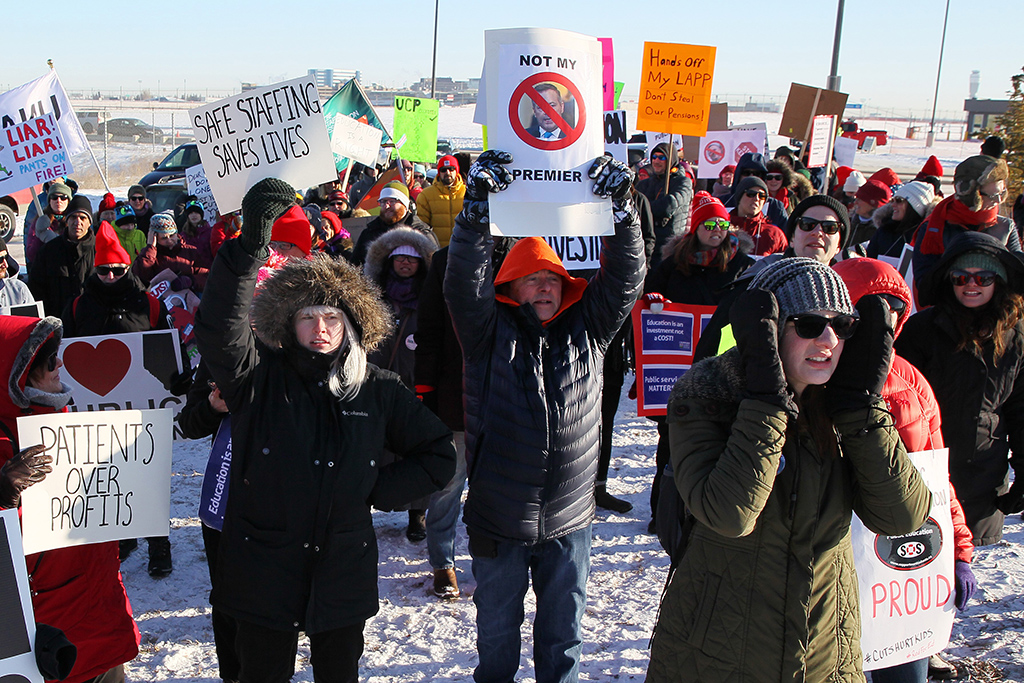
Hundreds of protesters, including supporters of public education and health systems, marched outside the United Conservative Party annual general meeting in Calgary in November 2019. Kenney has made a regular target of medical professionals and academics, cutting funding and ordering a reboot of K-12 curriculum he claimed was the secret plot of ‘radical socialists.’ In 2020, his government drafted a bill that granted it the power to arbitrarily declare peaceful protest illegal wherever and whenever.
Photo by Dave Chidley, the Canadian Press.
As I wrote at the time, this law has clear roots in white supremacy and a colonial mindset. Though it was crafted as an intimidation tactic against Indigenous people and communities, it ominously received royal assent as Albertans took to the streets to support the Black Lives Matter movement in the wake of George Floyd’s murder in 2020. Now it’s available to be used, in theory, to quash any public dissent against the government.
If you can’t say something nice, [redacted]
Academics across the country cried foul when Kenney, during a 2019 legislative session, dismissed critical analysis by University of Calgary political scientist Melanee Thomas by pointing out that she had been a candidate for the federal NDP in 2004 and 2006. The implication, crystal clear, was that Thomas was not a highly qualified expert in her field but just a partisan hack fighting for her team.
“I have to be honest: to be directly targeted by a head of government is chilling,” Thomas wrote on Twitter. “It is more so when that person is responsible for your institution’s funding and has just gutted its budget for the current fiscal year.”
In response, more than 600 academics from across Canada signed a letter to Kenney, condemning his words as an attack on academic freedom “consistent with an increased disregard for expert knowledge,” and reminding the premier of his “position of enormous power.”
This should not have been surprising. Before they even won power, the party clearly demonstrated a willingness to demonize individuals to make political hay. In 2018, Ed Whittingham, the former director of the Pembina Institute, was named to the board of the Alberta Energy Regulator by the Notley government. The UCP didn’t hesitate.
“It’s outrageous that the NDP government would appoint a foreign-funded, anti-oilsands, anti-pipeline activist like Mr. Whittingham to such an important government body,” blared a press release by UCP House leader Jason Nixon, now minister of environment and parks.
This was echoed in the pages of Canada’s largest newspaper chain. “Alberta’s NDP government has done it again — it has appointed an enemy of Alberta’s oil and gas industry to oversee it, regulate it and advise on it,” wrote Postmedia columnist Licia Corbella. (The Calgary Herald later admitted she had failed to disclose to her bosses or readers that she was a UCP member who voted in the party’s leadership race while simultaneously covering it.)
Oddly, this characterization as an enemy of the industry was not shared by the industry itself. Rather, Whittingham “provided a balanced voice to help bridge the divide in the economy versus environment debate,” Shell Canada president Michael Crothers has said. The Financial Post in 2016 called Pembina “the green group that industry could work with,” and said it had “collaborated with industry for decades to improve environmental practices rather than demand its demise.”
The two main lines of attack from the UCP and its allies were both familiar. One was that all who favour stronger environmental regulations are “anti-Alberta” by virtue of not wanting unchecked oil and gas expansion.
The other charge levied was that Pembina received vast sums from foreign “anti-Alberta” interests in order to wage war on the province and its oil and gas extractors. This line of attack, like the first, was not true.
But the Big Lie is a prime tactic of authoritarians because often it works — by inventing simplistic villains to rally against and blame for complex problems that actually require good faith to solve. As for Whittingham the foil, he quickly became the most hated man in the province. When the UCP released its platform for the provincial election, one specific pledge was to “Fire Ed Whittingham.”
The UCP won nearly 55 per cent of the popular vote. The day before Kenney was to be sworn in as premier, Whittingham submitted a resignation letter that noted “much effort was made to defame my character.” In response, Kenney tweeted, “It was gracious of Ed Whittingham to resign a day before we could fire him. Our government will never appoint people like him who are avowed opponents of Alberta jobs.”
Two months later, a public inquiry into supposed foreign funding of environmental groups was announced. In other words, let the show trials begin.
Enemies of the state
The inquiry was a campaign promise, predicated on the allegation that a sinister network of foreign funding was being directed to groups and activists for the purpose of attacking the Alberta oil and gas industry.
The notion was little more than a conspiracy theory, as demonstrated by the $3.5 million public inquiry launched by the UCP and conducted by forensic accountant Steve Allan. After requesting an extension for his deadline three times, Allan’s report found no illegal actions by any individuals or organizations. “Indeed, they have exercised their rights of free speech,” he wrote.
The New York Times headline said it all: “Alberta Took on Environmental Groups, But Only Proved They Did Nothing Wrong.”
The terms of reference for the inquiry were changed multiple times, broadening the scope from investigating those who used foreign funding to spread misinformation about oil and gas to include any groups who received foreign funding, even if they told the truth .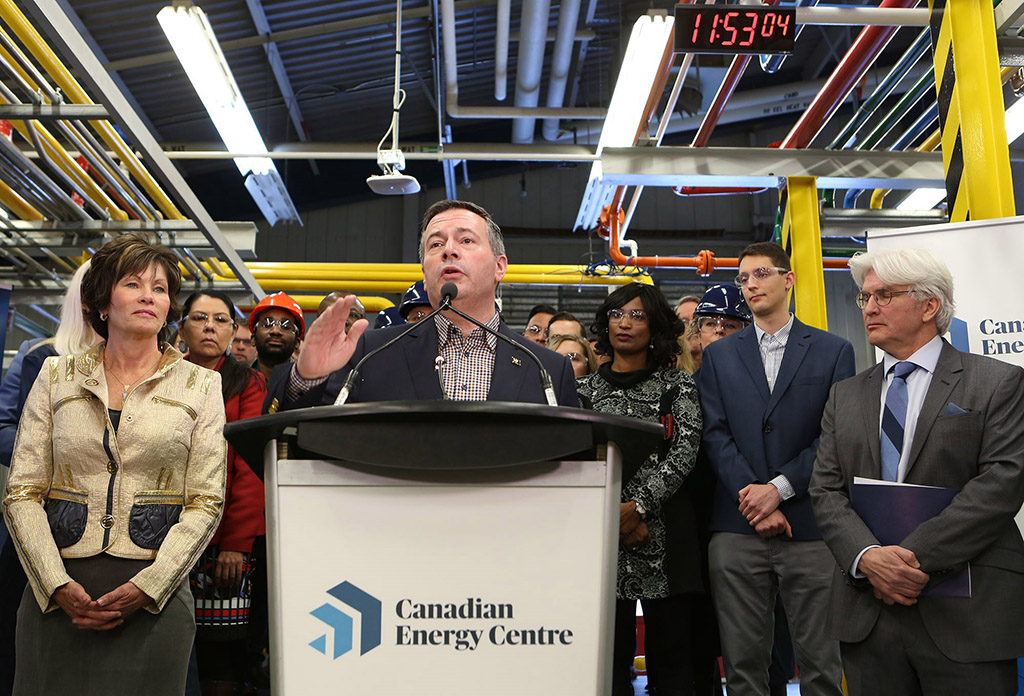
Kenney unveils the war room, otherwise known as the Canadian Energy Centre, in Calgary in December 2019. Shielded from public scrutiny and producer of one self-embarrassing headline after another, the propaganda factory nevertheless serves to advance authoritarian populism by projecting a narrative of endless warfare against villainous ‘anti-Albertan’ conspirators.
Photo by Greg Fulmes, the Canadian Press.
The inquiry itself brought to mind the U.S. Senate hearings led by Representative Joseph McCarthy in the 1950s that trampled people’s rights and reputations in pursuit of a supposed legion of Communist subversives within America’s institutions and among the wider populace.
Allan’s inquiry, too, started with the premise that certain people who disagreed with the state were threats to be exposed and punished. Like McCarthy’s inquisition, Allan’s two-year effort was lent a veneer of legitimacy and seriousness by the state; and as with the McCarthy hearings, the absurdity of its pretext risks obscuring its truly dangerous quality.
The government didn’t let reality get in the way of the narrative it preferred. “These groups were real, they targeted [oil and gas], they celebrated it when the projects were cancelled,” said Energy Minister Sonya Savage while announcing the report. “And I’m pretty convinced that they’re not the sole cause; they’re a pretty darn big cause of what happened to all our energy projects in Alberta.”
In November, several environmental organizations named in the report threatened to sue Kenney personally for defamation if he failed to retract and apologize for statements saying the inquiry found that they spread misinformation about the oil and gas industry. The government has retained outside counsel for the premier.
Undercutting intellectuals
The Kenney government’s overhaul of higher education, released in April 2021, is premised on the idea that post-secondary education should serve the needs of the private sector by being, essentially, a publicly-funded pipeline delivering human capital and “commercialized” research to the specifications of industry.
The plan, known as Alberta 2030, tilts towards polytechnic and trade schools and away from the province’s four research universities. That is evident in the funding cuts imposed by the Kenney government. The University of Calgary’s funding has dropped 18 per cent over the past two years, now receiving less in operational support from the province than in 2011.
The province’s flagship institution, the University of Alberta, has been hit worst of all. Despite consistent rankings as one of the top research universities in Canada, and despite contributing billions of dollars to the provincial economy each year, the school’s funding has been cut by more than $170 million under the UCP, including a $60 million reduction in the 2021 budget just two months before the Alberta 2030 plan was released.
“The UCP is a particular brand of anti-intellectual that I think is incredibly problematic for higher education, and universities in particular,” said Lexier at Mount Royal University. Kenney and his government harness free-market, neoliberal narratives as they go about slashing university budgets and raising tuition rates.
“The problem with that,” said Lexier, “is that it turns students into clients and customers, where they’re paying a hell of a lot of money to get a certain experience. So their relationship to the institution has changed, and our role as faculty has changed as well — we’re now employees rather than a community of scholars.”
The youth are our future
If Kenney perceived academia as something of a political or cultural threat, he seems to have seen elementary and secondary education as an opportunity.
When the NDP carried on the work of a long-overdue curriculum update initiated by the previous Progressive Conservative government, he feverishly attacked them as radical leftists with a “socialist agenda” who were remaking education “in secret” behind closed doors. “If the NDP tries to smuggle more of their politics into the classroom through their curriculum, we will put that curriculum through the shredder and go right back to the drawing board.”
Once elected, that’s just what the Kenney government did, as Education Minister Adriana LaGrange appointed a panel to revise the NDP’s revisions. When the draft curriculum was leaked in October 2020, it was widely panned by parents, teachers and education experts as racist and Eurocentric, promoting a burnished image of the oil and gas industry and seeking “balance” in lessons about climate change.
David Scott, an associate professor of education at the University of Calgary, wrote an article on the UCP’s approach. “Seen within the context of the rise of authoritarian populism, the advisory panel’s various recommendations reflect a belief that societal values are trending in the wrong direction, and the K–4 program can be used as a tool to reinstate what are perceived as traditional values and beliefs,” wrote Scott.
He pointed to the removal from the K-4 curriculum of any reference to residential schools, “notions of equity and an ecological world view” as “an attempt to ensure that children will not be exposed to histories, values and beliefs [the UCP] associated with left-wing ideologies.”
Instead, the recommendation that students memorize “a particular and common body of historical facts points to fears that society is losing the authority of a legitimizing historical narrative that has sustained Canadian society in the past, which social studies has a mission to re-establish.”
It’s worth pointing out, as Scott does, that the existing social studies program was considered “one of the most forward-thinking” of its time when introduced in 2005. To quote the program itself, teachers should help students become “engaged in the democratic process and aware of their capacity to effect change in their communities, society and world.” The premier at the time was noted radical socialist Ralph Klein.
“Education is an incredibly powerful tool for social change,” Lexier observed. “It can also be an incredibly powerful tool to prevent social change.”
Ministry of Bigfoot bashing
Every government spins, trying to frame the narrative in ways that benefit it. But Kenney’s approach is to manufacture propaganda at an industrial scale. Exhibit A: The creation of the Canadian Energy Centre — more widely known as the “energy war room.”
The war room was established by the government as a private corporation, thus placing it outside the reach of freedom of information access. It has picked some big targets — like the New York Times, which it declared an enemy of Albertans for publishing a story that accurately noted investors were shying away from the oilsands.
Eventually war-roomers trained their guns on Bigfoot. That would be the animated Netflix children’s film called Bigfoot Family, attacked for spreading unacceptable misinformation about the oil and gas industry. Kenney said the film’s intent was to “defame in the most vicious way possible, in the impressionable minds of kids, the largest industry in the province.”
Widespread mockery ensued. “Alberta’s war room counters ‘Bigfoot Family’ with $50 million production of ‘Peter the Pipeline,’” quipped satire site the Beaverton.
Underlying the farce, however, is the uncomfortable reality that a Canadian government spent millions in public money to wage a public relations war on behalf of wealthy corporations that ran the gamut from purchasing misleading billboards in Times Square to attacking free speech in cartoons. Even more uncomfortable is that many Albertans supported it.
‘Imagine’
Though such tactics may seem alarming and unprecedented in this country, it’s important to note that the Canadian colonial project is itself authoritarian, designed to impose a particular worldview on unwilling people, by force if necessary. The heavy hand of the state is hardly novel for many, particularly Indigenous and Black people. Strikingly, as more Canadians have slowly but increasingly begun to recognize these ugly truths, Kenney has clung to the myths and symbols of colonialism.
He rushed to defend Canada’s racist first prime minister John A. Macdonald, for example, as “an imperfect man [who] was still a great leader” at the moment when the discovery of unmarked graves of Indigenous children heightened outcry about Canada’s residential schools.
For Lexier, the UCP government’s actions are by purpose and design. “I think it would be nice to think that this was just their semi-competent, stumbling-through mess that they make it seem like it is,” she said, reflecting on boondoggles like the war room. “But we should give conservatives a lot more credit for their strategy and really intense thinking about society and how it functions and where the bases of power are.”
When Lexier talks about how it feels to live under Kenney’s government as a person who doesn’t share its politics, she describes the state using its might to punish and reward in order to create division. “It’s about silencing us, driving us out of the province and undercutting our power as much as possible.”
Many who can afford to are indeed leaving. In response to the UCP’s policies, more than four in 10 of Alberta’s doctors have considered exiting the province. Though the government downplayed such things publicly, it was tracking hundreds of rural physicians considered at risk for closing or altering their practices — and, in character, it acted unilaterally to bar doctors from leaving en masse.
Lexier said that while there are plenty of UCP supporters in academia, the overall mood is one of exhaustion. She said 12 of her colleagues have left the province in the last two years, and she estimates that “more than half” of those remaining are actively looking for positions elsewhere, including herself.
“A lot of people have left because this province is horrible for academics,” she said. “Before the UCP was elected, I thought this would be the place I would stay. I was happy to settle here. I hadn’t looked at a job posting in 10 years, and now I’m looking all the time.”
Drwiega, who described his views as “very conservative” before leaving Alberta for his undergrad, is now pursuing his master’s in musical theatre in Scotland. He said that he doesn’t see himself returning to build a career in Alberta, not only because of the lack of investment in the arts, but also the direction of the political culture.
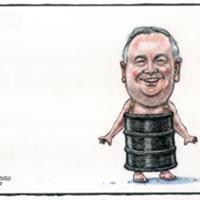
The Emperor Kenney’s New Clothes READ MORE
“I’m not a big, huge name,” said Drwiega, “but the government felt the need to squash my little speech. I think it was an excellent example of the United Conservative Party and the kind of government that they are.”
History shows that authoritarian governments tend to arise when times get harder and less certain for the citizenry, which is certainly part of how the UCP got elected. And while Alberta’s economy is picking up again thanks to rising oil prices, pumping more bitumen while slagging those who toil in other sectors, from hospitals to renewable energy to university classrooms, isn’t likely to bring back the boom times. More likely, such a strategy will only drag out Alberta’s economic pain — and the resentment it engenders — for those who feel it most.
“When your life is shitty and you’ve lost your job and everything sucks, people are going to turn to that explanation of blaming other people,” said Lexier. “I’m scared, honestly.”
She then referenced another idea that Kenney has floated. “Imagine,” she said, “a province like this having its own police force.” 

 Brandi Fullwood
Brandi Fullwood Libby Denkmann
Libby Denkmann Brandi Fullwood
Brandi Fullwood Libby Denkmann
Libby Denkmann




